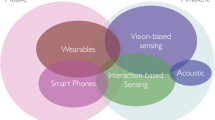Abstract
Increasing attention to the research on activity monitoring in smart homes has motivated the employment of ambient intelligence to reduce the deployment cost and solve the privacy issue. Several approaches have been proposed for multi-resident activity recognition, however, there still lacks a comprehensive benchmark for future research and practical selection of models. In this paper, we study different methods for multi-resident activity recognition and evaluate them on the same sets of data. In particular, we explore the effectiveness and efficiency of temporal learning algorithms using sequential data and non-temporal learning algorithms using temporally-manipulated features. In the experiments we compare and analyse the results of the studied methods using datasets from three smart homes.








Similar content being viewed by others
Explore related subjects
Discover the latest articles and news from researchers in related subjects, suggested using machine learning.References
Alemdar H, Ertan H, Incel OD, Ersoy C (2013) Aras human activity datasets in multiple homes with multiple residents. In: PervasiveHealth’13. ICST, Brussels, Belgium, pp 232–235. https://doi.org/10.4108/icst.pervasivehealth.2013.252120
Benmansour A, Bouchachia A, Feham M (2015) Multioccupant activity recognition in pervasive smart home environments. ACM Comput Surv 48(3):34:1–34:36
Brand M, Oliver N, Pentland A (1997) Coupled hidden Markov models for complex action recognition. In: Proceedings of the 1997 conference on computer vision and pattern recognition, CVPR’97. IEEE Computer Society, Washington, DC, USA, p 994
Chen R, Tong Y (2014) A two-stage method for solving multi-resident activity recognition in smart environments. Entropy 16(4):2184
Chiang YT, Hsu KC, Lu CH, Fu LC, Hsu JYJ (2010) Interaction models for multiple-resident activity recognition in a smart home. In: IEEE/RSJ international conference on IROS, pp 3753–3758. https://doi.org/10.1109/IROS.2010.5650340
Cho K, van Merrienboer B, Gulcehre C, Bahdanau D, Bougares F, Schwenk H, Bengio Y (2014) Learning phrase representations using RNN encoder–decoder for statistical machine translation. In: Proceedings of the 2014 conference on empirical methods in natural language processing, pp 1724–1734
Cook DJ (2012) Learning setting-generalized activity models for smart spaces. IEEE Intell Syst 27:32–38. https://doi.org/10.1109/MIS.2010.112
Cook DJ, Crandall A, Singla G, Thomas B (2010) Detection of social interaction in smart spaces. Cybern Syst 41(2):90–104. https://doi.org/10.1080/01969720903584183
Crandall AS, Cook DJ (2008) Resident and caregiver: handling multiple people in a smart care facility. In: Proceedings of AAAI fall symposium—AI in eldercare—new solutions to old problems, AAAI technical report, vol FS-08-02. AAAI. http://www.aaai.org/Library/Symposia/Fall/fs08-02.php
Das SK, Cook DJ (2004) Health monitoring in an agent-based smart home. In: Proceedings of the international conference on smart homes and health telematics. ICOST, IOS Press, pp 3–14
Ghahramani Z, Jordan MI (1997) Factorial hidden Markov models. Mach Learn 29(2–3):245–273. https://doi.org/10.1023/A:1007425814087
Hochreiter S, Schmidhuber J (1997) Long short-term memory. Neural Comput 9(8):1735–1780. https://doi.org/10.1162/neco.1997.9.8.1735
Hsu KC, Chiang YT, Lin GY, Lu CH, Hsu JYJ, Fu LC (2010) Strategies for inference mechanism of conditional random fields for multiple-resident activity recognition in a smart home. Springer, Berlin, pp 417–426. https://doi.org/10.1007/978-3-642-13022-9_42
Plötz T, Hammerla NY, Olivier P (2011) Feature learning for activity recognition in ubiquitous computing. In: Proceedings of the twenty-second international joint conference on artificial intelligence—volume two, IJCAI’11. AAAI Press, pp 1729–1734
Poppe R (2010) A survey on vision-based human action recognition. Image Vis Comput 28(6):976–990
Prossegger M, Bouchachia A (2014) Multi-resident activity recognition using incremental decision trees. In: Adaptive and intelligent systems—third international conference, ICAIS 2014, Bournemouth, UK, September 8–10, 2014. Proceedings, pp 182–191
Rabiner LR (1990) Readings in speech recognition. A tutorial on hidden markov models and selected applications in speech recognition. Morgan Kaufmann Publishers Inc., San Francisco, pp 267–296
Saini R, Kumar P, PratimRoy P, Dogra DP (2018) A novel framework of continuous human-activity recognition using kinect. Neurocomputing 311:99–111
Singla G, Cook DJ, Schmitter-Edgecombe M (2010) Recognizing independent and joint activities among multiple residents in smart environments. J Ambient Intell Humaniz Comput 1(1):57–63. https://doi.org/10.1007/s12652-009-0007-1
Son NT, Qing Z, Mohan K (2017) Improving multi-resident activity recognition for smarter home. In: IJCAI 2017 WS on AI for IoT, IJCAI’17
Sutton C, McCallum A, Rohanimanesh K (2007) Dynamic conditional random fields: factorized probabilistic models for labeling and segmenting sequence data. J Mach Learn Res 8:693–723
Tunca C, Alemdar H, Ertan H, Incel OD, Ersoy C (2014) Multimodal wireless sensor network-based ambient assisted living in real homes with multiple residents. Sensors 14:9692–9719
van Kasteren T, Noulas A, Englebienne G, Kröse B (2008) Accurate activity recognition in a home setting. In: Proceedings of the 10th international conference on ubiquitous computing, UbiComp’08. ACM, New York, NY, USA, pp 1–9. https://doi.org/10.1145/1409635.1409637
Wang L, Gu T, Tao X, Chen H, Lu J (2011) Recognizing multi-user activities using wearable sensors in a smart home. Pervasive Mob Comput 7(3):287–298. https://doi.org/10.1016/j.pmcj.2010.11.008
Wilson DH, Atkeson C (2005) Simultaneous tracking and activity recognition (star) using many anonymous, binary sensors. In: Proceedings of the third international conference on pervasive computing, PERVASIVE’05. Springer, Berlin, pp 62–79. https://doi.org/10.1007/11428572_5
Author information
Authors and Affiliations
Corresponding author
Additional information
Publisher's Note
Springer Nature remains neutral with regard to jurisdictional claims in published maps and institutional affiliations.
Rights and permissions
About this article
Cite this article
Tran, S.N., Nguyen, D., Ngo, TS. et al. On multi-resident activity recognition in ambient smart-homes. Artif Intell Rev 53, 3929–3945 (2020). https://doi.org/10.1007/s10462-019-09783-8
Published:
Issue Date:
DOI: https://doi.org/10.1007/s10462-019-09783-8
Keywords
Profiles
- Son N. Tran View author profile




